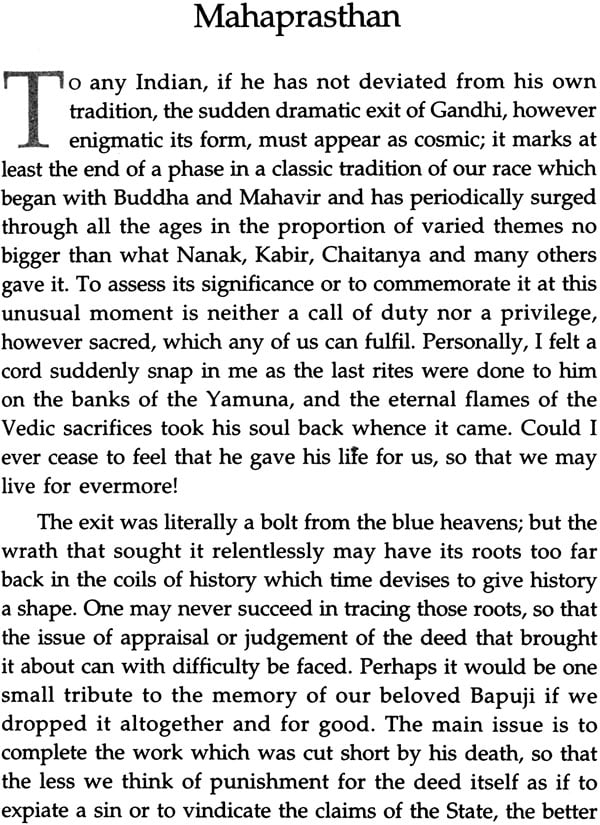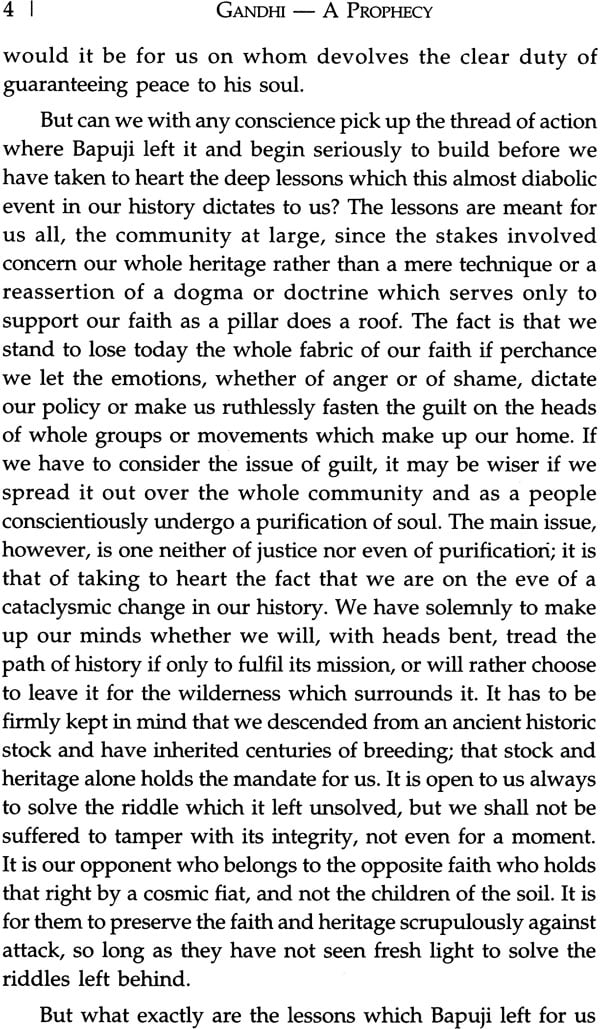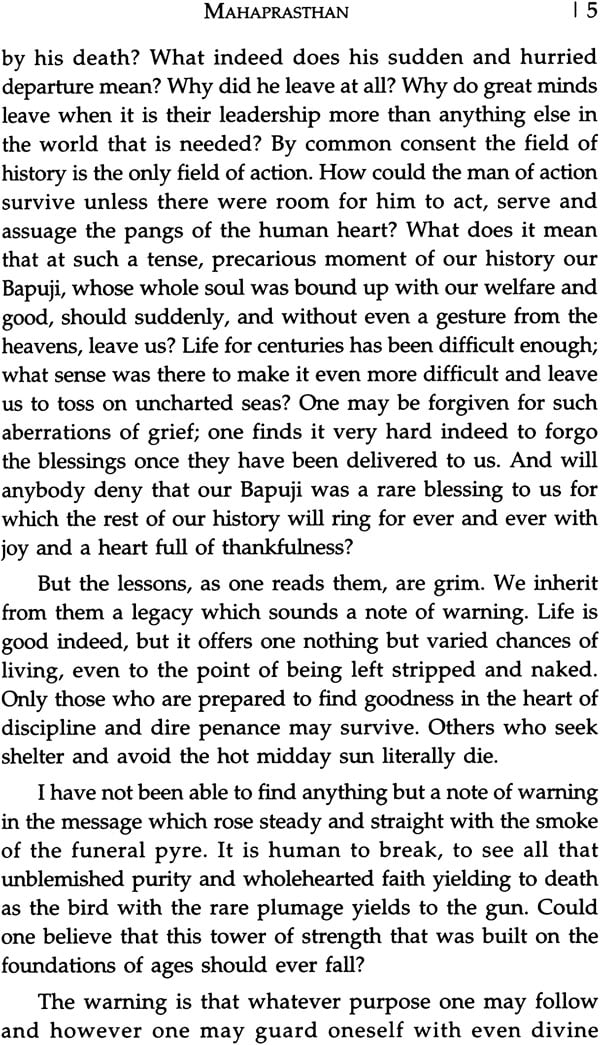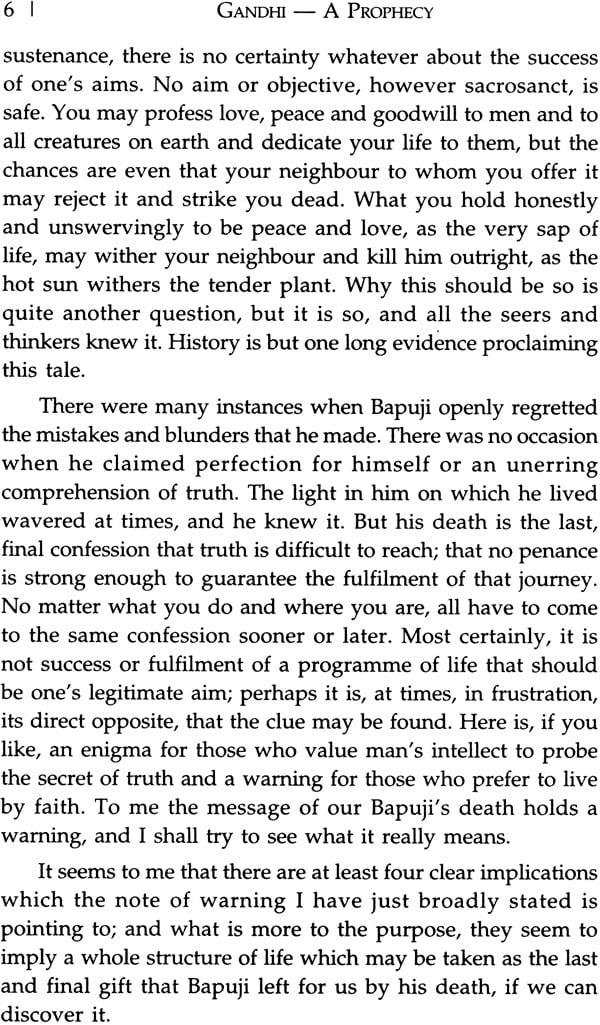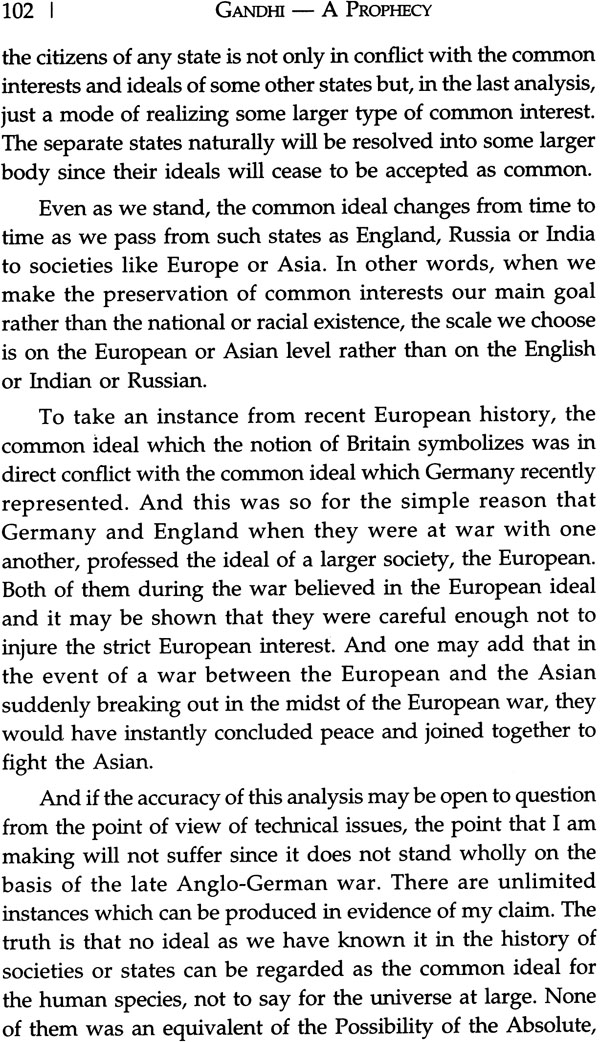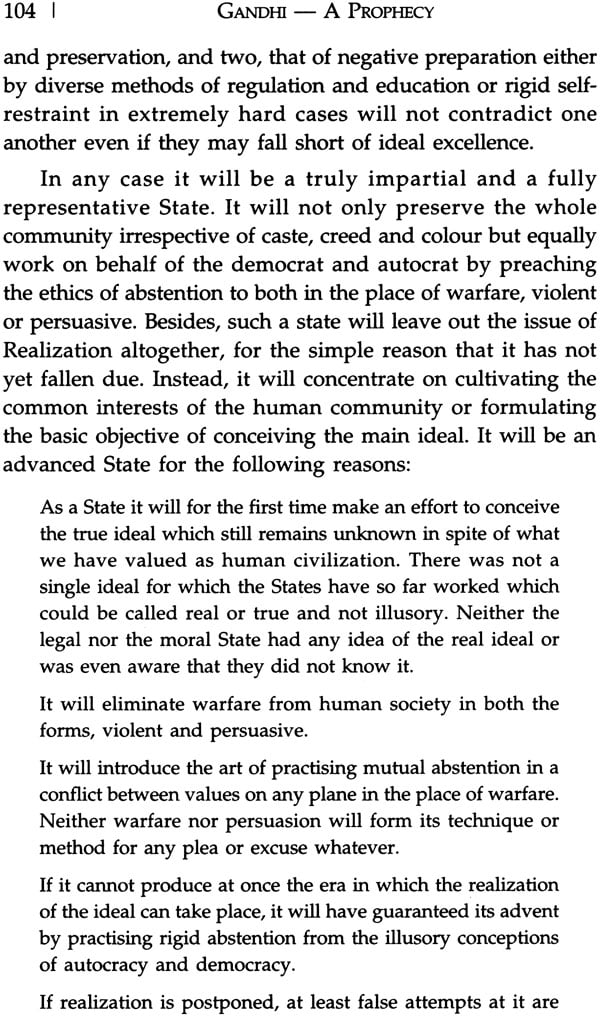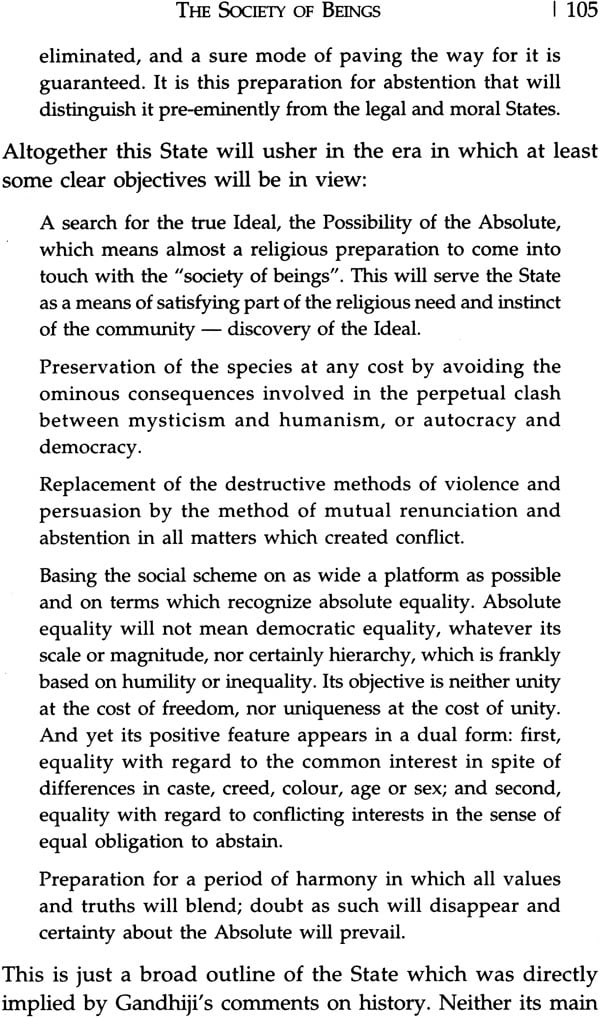
Gandhi - A Prophecy
Book Specification
| Item Code: | NAI025 |
| Author: | B.K. Mallik |
| Publisher: | D. K. Printworld Pvt. Ltd. |
| Language: | English |
| Edition: | 2014 |
| ISBN: | 9788124607558 |
| Pages: | 128 |
| Cover: | Hardcover |
| Other Details | 9 inch X 6 inch |
| Weight | 350 gm |
Book Description
This book written almost immediately after Gandhi's demise suggests a fresh view of his struggle to achieve "peace in the human home" embedded as it is in Mallik's socio-philosophical theory of conflict and its avoidance.
Further in the light of the author's view of the dynamics of history, it reads the life and death of Mahatma Gandhi as more than a mere episode in the milieu of traditional value: it is projected as a significant event which opens up new and unprecedented possibilities for the future of man.
As an original and thought- provoking perspective it should invoke the interest of Gandhians, philosophers and historians alike.
Philosopher Basanta Kumar Mallik (1879-1958), MA Philosophy (Calcutta University), worked as tutor and administrator in Nepal and did further studies in law and anthropology at Oxford, where he also wrote a philosophical thesis on Freedom. When he finally returned to Oxford he lectured through the war years and wrote several philosophical books including The Real & the Negative (London: George Allen & Unwin 1940), Related Multiplicity Oxford: Hall the Publisher, 1952), Non Absolutes (London: Vincent Stuart, 1956) and Mythology & Possibility (London: Vincent Stuart, 1960). Other works include The Individual and the Group (London: George Allen & Unwin, 1939) and The Towering Wave (Vincent Stuart Publishers, 1953, republished by D.K. Printworld, 2014).
GANDHI is sometimes described as the greatest man of the twentieth century. Interest in him has never flagged and may even be increasing amongst scholars and activists the world over. Well known are several outstanding protest movements inspired by Gandhian Satyagraha as of Martin Luther King, Lech Walesa, Vaclav Havel and a host of others less renowned.
Green movements have drawn on his critique of industrial, urban and economic aspects of modernization, capitalist or communist. Independent India has always had its quota of Gandhian scholars, NGOs, political activists and social reformers. However despite the government's homage to the Mahatma through various observances and rituals, in no significant sense does Gandhi's spirit inform India's state and society, her economic or industrial policies, or her growing urbanization and consumerism. Despite schemes to alleviate rural poverty or devolve powers to village panchayats the central thrust of the Indian state and its self-definition are and have been focused on modernization.
Basanta Kumar Mallik (1876-1958) spent his formative years in the last quarter of the nineteenth century in Bengal, a leading storm centre of what has been described as the Indian Renaissance, out of which emerged poets, writers, mystics, religious and social reformers, philosophers, and inspired by them, politicians and revolutionaries. Mallik belonged to an old Vaishnava family from Nadia, a part of Bengal that had been home to Chaitanya's bhakti and the Nava-Nyaya philosophical movements, and indeed he displayed in himself outstanding qualities of both heart and mind, an acute philosophical intellect combined with a spiritual and poetic sensibility.
Like many of his countrymen Mallik was an ardent admirer of Mahatma Gandhi. He was inspired by Gandhi's faith in ahimsa and his untiring quest for non-violentizing (to borrow a phrase from Robert Holmes") conflicts, of which the major two in the India of his time were staged between Indian nationalism and the British Raj, and between the Hindu and Muslim communities. He was also excited by Gandhi's attempt to define India primarily in her own categories, social, moral and cultural, and shared his belief that India's civilization was rooted in her villages. As a philosopher-cum-social thinker Mallik dug even deeper into these concepts, using logical and civilizational analysis which often went beyond Gandhi's stated thoughts and writings. Thus we find him tackling problems of peace and social harmony, or analysing Hindu- Muslim relations (see his The Individual and the Group, 1939) in categories which do not appear to be strictly derivative from the Mahatma's. But Mallik believed himself to be essentially engaged in the same pursuits of peace and social harmony and that his theoretical formulations were implicit in Gandhi's. He writes: "what I came to uphold as ... logical thought was verified to the hilt by action spread over half-a-century in the life of Gandhi."? As a meta-historian, therefore, Gandhi's sudden departure before the completion of his life's task was an event that required explanation.
Gandhi: A Prophecy, a slender book put together shortly after Gandhi's death, begins and ends with two stand-alone pieces. It starts with his immediate response to the news of Gandhi's assassination, the opening chapter "Mahaprasthan" which had been circulated privately amongst his friends, as had the final "Sravana - The 15th" written five months earlier on the occasion of India's Independence in 1947. The ideas expressed in both are essentially similar as Mallik asserts in: GAP: "My vision of the 15th of Sravana stands, and it stands confirmed by the message of Bapuji."
Thus although Mahaprasthan is indeed an authentic cri de Coeur uttered in a state of heightened consciousness brought on by intense grief, it is very much a Mallikean statement though made through the medium of (an incorporeal) Gandhi. Interested literary and other scholars may want to analyse the psychic, poetic and other dimensions of Mallik's claims to record what Gandhi is dictating to his mind - but what concerns the reader is the message.
In a short space of about seventy pages the chapters between Mahaprasthan and Sravana provide a brief synoptic of the philosophical-cum-sociological arguments of Mallik's metaphysical tome.' easily grasped by close friends familiar with his thought, but a challenge to readers exposed to his thinking for the first time. They could also bear in mind that the philosophical environment in which he lived, whether in Calcutta or Oxford, had a strong presence of British idealism (later overtaken by positivism and analytic philosophy), Hegelianism, and the phenomenon of Marxism whether enshrined in the Communist Party of the Soviet Union which captured power in 1917 - i.e. while Mallik was still reading at Oxford, or the minds of several Bengali intellectuals with whom he interacted in Calcutta in the 1920s and 1930s. The development of atomic physics generated its own excitement in the philosophic world. Mallik's unique metaphysical system reflects his acquaintance with and responses to some of these ideas and events, interwoven with recognizably Indian structures of thought.
The opening text elaborates on a warning sounded by Gandhi after his death, drawing lessons from his unfulfilled struggle to realize his overreaching goal of "peace in the human home", for Mallik firmly believed that Gandhi desired not only freedom for an undivided India through non-violent means (in which endeavour he experienced frustration), but peace for the whole world, and indeed peace is essentially indivisible. The warning, proclaiming the necessary conditions for successfully achieving not only stable peace, but any ideal an individual may conceive of, is implicitly deduced as it were, from the lessons drawn from his own life.
To better understand the drift of his arguments couched in his particular terminology, one must provide some gloss for a few terms howsoever condensed and inadequate, though there is no substitute for reading his original strictly philosophical work.' Some of these key terms are "moral and legal states", "authoritarian and libertarian" societies, and the "society of beings".
| | ||
| | ||
| Mahaprasthan | 3 | |
| | ||
| | ||
| I | Legal and Moral Values | 23 |
| II | The Long Night of History | 31 |
| III | An Experiment with Tradition | 37 |
| IV | Mysticks, Humanists and Sceptics | 48 |
| V | Asceticism contra Freedom | 59 |
| VI | Atoms : The Duality of the Unique | 73 |
| VII | Posibility of the Absolute | 92 |
| VIII | The Society of Beings | 97 |
| | 108 |
